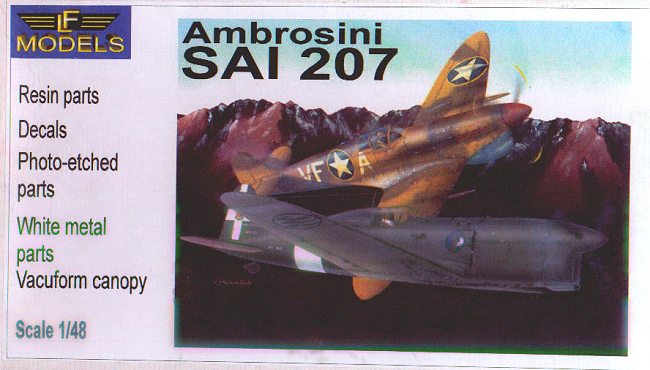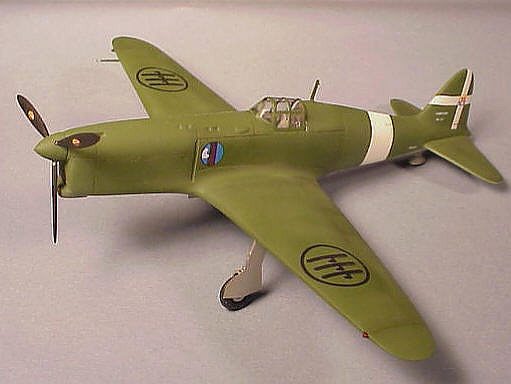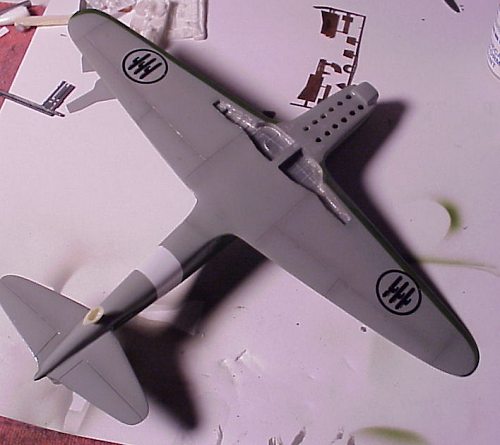
LF Models 1/48 SAI 207
|
KIT # |
4801 |
|
PRICE: |
@$30.00 |
|
DECALS: |
One aircraft |
|
REVIEW : |
Allan Wanta |
|
NOTES: |
Resin multimedia kit. Metal landing gear |

|
HISTORY |

Historical section by Scott Van Aken:
Most of the major powers involved in the European portion of WWII at one time or another undertook the development of a lightweight fighter. The key to these aircraft was that they use very little in the way of valuable strategic resources, in this case, aluminum. Instead, the majority of the airframe for these light fighters was made of wood. While structurally as good as aluminum, wood requires special handling and a bit more power as a wooden planes tends to be a bit heavier than its aluminum counterpart.
The Italians built what was probably the most capable and successful of the lightweight fighters, however time was not on their side in this regard and the capitulation of the Italian government pretty well stopped these aircraft from entering squadron service.
 Design of the
fighter started in 1939. It was started as a single-seat test aircraft, the SAI
107, which was based on the previous SAI.7 two seat sports monoplane . The SAI
107 was powered by a 540hp Isotta-Fraschini engine and weighed but 2,200 lbs
fully loaded. It reached a top speed of 350 mph, which was not bad at all and
raised hopes. During the development of the 107, a fully militarized version,
the SAI 207 was planned and construction started.
Design of the
fighter started in 1939. It was started as a single-seat test aircraft, the SAI
107, which was based on the previous SAI.7 two seat sports monoplane . The SAI
107 was powered by a 540hp Isotta-Fraschini engine and weighed but 2,200 lbs
fully loaded. It reached a top speed of 350 mph, which was not bad at all and
raised hopes. During the development of the 107, a fully militarized version,
the SAI 207 was planned and construction started.
Once completed, it entered flight testing and reached a maximum speed of nearly 400mph in military trim. Of course, the engine used was a more powerful 750 hp Isotta-Fraschini, but there were smiles everywhere when testing proved so successful. An order for 2,000 aircraft was placed. The initial batch of pre-production SAI 207s was started in 1942. However, only thirteen were completed before the Italian Air Ministry cancelled the order in favor of the more powerful SAI 403.
|
THE KIT |
L
F Models, not exactly a household name here in the U.S., is one of a hand full of Czech Republic cottage resin companies to spring up in the last 8 years or so. What LF has done has been a mixture of obscure Luftwaffe, Pre-WW 2, and other lesser know aircraft kits. Amongst them was this little known light defensive point fighter. I didn't find a whole lot of information on this version, although what I did find seems to match up pretty well with the kit as presented. The LF Models resin kit is well molded of a light tan colored resin that appears to be free of surface bubbles and pin holes. Upon closer inspection I found some tiny holes and a bit more excessive resin on the parts than you might find on some other resin kits, this however was only a minor annoyance and they were easily removed. One clear vacuformed canopy was also included. Instructions are a single letter size with exploded view, no writing. They were also a bit lacking in firm location of items; better have a good reference! Decals are for one fictitious aircraft.|
CONSTRUCTION |
 As with most resin kits, the hardest part of assembly is the
cleanup and preparation of the parts. You will, as I did, need some body filler
to repair surface imperfections and fill the customary gaps in fitting the
pieces. The largest gap was between the one-piece wing and the fuselage; it's
made a little easier to clean up in the fact that the gap is 5 or some
millimeters away from the actual fuselage on the upper surfaces. The ailerons
are butt joined to the rear of the fuselage, an attempt at slots and tabs were
made to fix the pieces together but they ended up being filled in with big nasty
air bubbles, it really wasn't worth the while to fix.
As with most resin kits, the hardest part of assembly is the
cleanup and preparation of the parts. You will, as I did, need some body filler
to repair surface imperfections and fill the customary gaps in fitting the
pieces. The largest gap was between the one-piece wing and the fuselage; it's
made a little easier to clean up in the fact that the gap is 5 or some
millimeters away from the actual fuselage on the upper surfaces. The ailerons
are butt joined to the rear of the fuselage, an attempt at slots and tabs were
made to fix the pieces together but they ended up being filled in with big nasty
air bubbles, it really wasn't worth the while to fix.
The kit contains a photo etched fret which can best be described ' why did they do this?' Very little on the fret would improve the kits' overall appearance, and those parts that would matter are most difficult to even work with. For example, the venturi tube mounted on the right fuselage under the canopy, was two pieces of photo etched hell. Imagine bending two spring steel brass strips into a cone shaped venturi and you see what I mean. Believe it or not, I actually tried to form one into a cone, you guessed it, circular file bin time. Simpler ways of making that part do exist, try stretching plastic tube stock and cutting it to size, looks pretty good.
Now the kit was actually looking like a plane, but the engraving was a bit too delicate when it comes to the movable surfaces, they end up needing some help from an engraving tool. There wasn't a whole lot of surface detail on the original thank goodness, but what there was is not well represented in the kit. So be ready to add a few bumps and hinges on the under sides of the flying surfaces, and air cooler intakes on the upper surface of the cowling.
|
PAINT & DECALS |
 The painting as one might expect was pretty simple, late war
green over late war light gray, not terribly exciting, but I tried to make the
best of it by adding the customary white fuselage band and tail cross using Mr.
Color primary white. The decal sheet looked pretty hopeless in first reviewing
the kit, but after I got them applied I was pretty impressed, colors and opacity
looked very nice. Seeing that the whole upper surface was little more than a
green field, I decided to shade areas with lighter and darker shades of the
original color to break up the monotony.
The painting as one might expect was pretty simple, late war
green over late war light gray, not terribly exciting, but I tried to make the
best of it by adding the customary white fuselage band and tail cross using Mr.
Color primary white. The decal sheet looked pretty hopeless in first reviewing
the kit, but after I got them applied I was pretty impressed, colors and opacity
looked very nice. Seeing that the whole upper surface was little more than a
green field, I decided to shade areas with lighter and darker shades of the
original color to break up the monotony.
Canopy time! Do you sweat and shudder when it comes time to affix the dreaded Vacuform canopy? Especially when only one is supplied? Well I do, luck always runs with the foolish and that's all I need to say about that. Coat the thing with Future floor wax, mask with Bare Metal foil, and run. Otherwise it wasn't too difficult, just be patient with fitting it to the fuselage opening. No gun-sight was supplied and I doubt this small aircraft was equipped with a proper one, so let's add an exterior bead and crosshair type typically found on Italian fighters as a backup to the normal gun-sight.
|
CONCLUSIONS |
Well, the assembly of this kit was no less than challenging, but not overly so, that makes it suitable for modelers with some scratch-building experience and resin kits in their resume. A definite departure from the usual Macchi and Fiats typically found in the Italian section of most display shelves. Keep up the good work LF Models.
|
REFERENCES |
War Planes of the Second World War, Fighters, vol 2, by William Green, Doubleday, 1961 (1st Edition)
Copyright ModelingMadness.com. All rights reserved. No reproduction in any form without express permission from the editor.
If you would like your product reviewed fairly and quickly, please contact the editor or see other details in the Note to Contributors.
Back to Reviews Page 2025